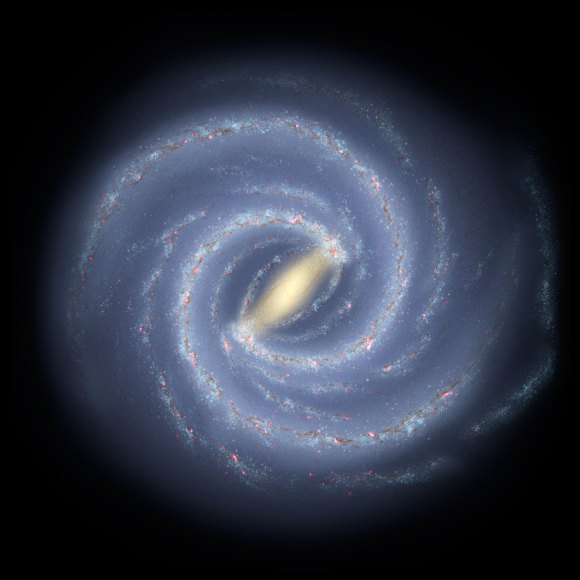A bar of stars at the center of the Milky Way looks surprisingly young
Future models of the galaxy’s evolution will have to account for why the bar developed so late

The bar-shaped accumulation of stars at the center of the Milky Way (illustrated) might be billions of years younger than the rest of our galaxy.
R. Hurt/JPL-Caltech/NASA, ESO
- More than 2 years ago
The biography of our home galaxy may be due for some revisions. That’s because a bar-shaped collection of stars at the center of the Milky Way appears to be much younger than expected.
The bar is a prominent feature of our galaxy (SN: 6/25/21). It spans thousands of light-years and links the galaxy’s spiraling arms of stars, making them resemble streams of water coming from a spinning lawn sprinkler. In computer simulations of the Milky Way’s evolution, the bar tends to form early in the galaxy’s roughly 13-billion-year lifetime. But the ages and locations of metal-rich stars suggest the bar finished forming just a few billion years ago, researchers report. The study, submitted November 28 to arXiv.org, is in press at Astronomy & Astrophysics Letters.
“These metal-rich stars are basically like fossil records of ancient stars that are telling the story of our home galaxy,” says Samir Nepal, an astrophysicist at the Leibniz Institute for Astrophysics Potsdam in Germany.
Stars with large proportions of metal elements are built from the remnants of stars that have since exploded, ejecting the metals they forged from lighter elements. Those spewed metals enrich the materials in the core of galaxies like the Milky Way, which is why a new generation of metal-rich stars can form only deep inside galaxies. The spinning bar at the center of the Milky Way then scattered some of those stars throughout our galaxy.
Using data from the European Space Agency’s Gaia space telescope, Nepal and colleagues reconstructed the development of the Milky Way bar through its influence on the distribution of metal-rich stars (SN: 5/9/18). They inferred the bar’s history, just as you might deduce where the batters stand in a baseball game by looking at the flight of the balls they hit, even if you can’t see home plate.
In tracking the ages of the metal-rich stars, the researchers identified a burst of star formation in the central part of the galaxy that petered out about 3 billion years ago. The downturn seems to mark the end of the Milky Way bar’s developmental phase, the researchers report. After that burst, they say, the inflow of new material into the bar probably dropped off substantially. That suggests the bar we see today is a stable feature that’s about 10 billion years younger than the galaxy as a whole.
The new insights about the metal-rich stars “are like the tip of the iceberg” of data coming from the Gaia telescope, says astrophysicist Cristina Chiappini, also with the Leibniz Institute for Astrophysics Potsdam. Assuming the revised age estimate of the bar is confirmed, future models of the galaxy’s evolution will have to account for why the bar developed so late.
The study has broader implications than correcting the history of our galaxy, says Ortwin Gerhard, an astrophysicist at the Max Planck Institute for Extraterrestrial Physics in Garching, Germany, who was not involved in the research. “The possibility of detailed observations of the motions and chemical abundances of stars in the Milky Way, particularly based on [data] from the Gaia satellite,” he says, means we can “expect to learn about the evolution of bars [in other galaxies] generally by studying the bar in the Milky Way.”







